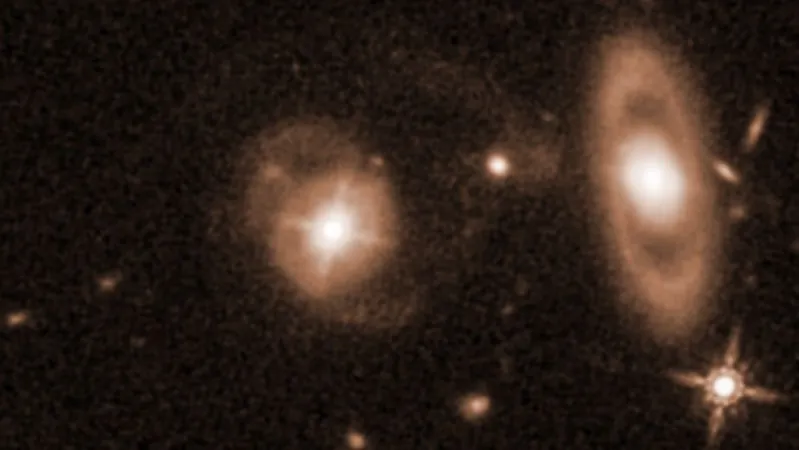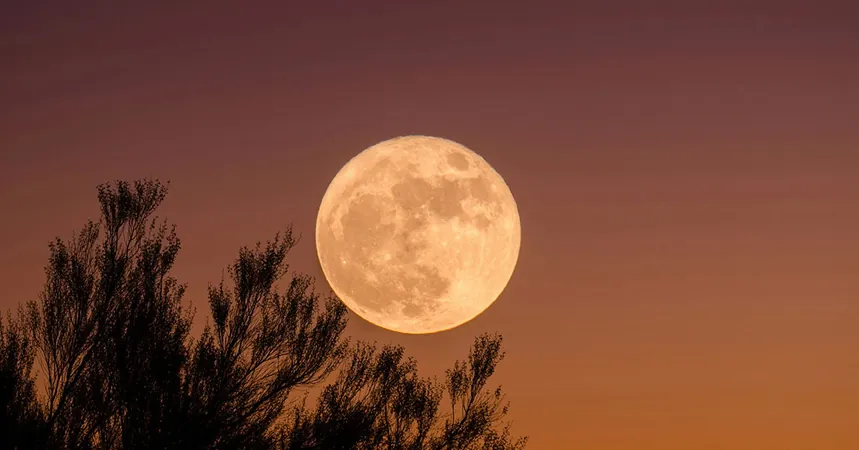
Astronomers Stunned by Mysterious Spiral Galaxy Jet: New Clues to Cosmic Evolution!
2025-01-14
Author: Arjun
Introduction
A captivating image from the Hubble Space Telescope has recently caught the attention of astronomers, showcasing a collection of galaxies located approximately 5.94 billion light-years away. However, the real intrigue stems from what remains hidden from sight—evident only through radio emissions emanating from a central galaxy that is home to a supermassive black hole over 400 million times heavier than our Sun.
The Mystery of J0742+2704
This galaxy, known as a quasar designated J0742+2704, is expelling a powerful jet that could potentially unlock new understanding about the interplay between galaxies and their black holes over cosmic timescales. Yet, the origin of this astonishing jet poses a significant mystery. Historically, these jets are known to erupt from elliptical galaxies shaped by violent mergers with other galaxies. Such interactions typically funnel gas and dust toward colossal black holes at the hearts of these galaxies, further fueling the jets. But J0742+2704’s spiral structure suggests it has remained undisturbed by such mergers, prompting astronomers to ponder the source of its jet.
Reactions from Astronomers
Olivia Achenbach, a researcher at the United States Naval Academy, expressed her initial surprise, stating, "At first, I thought I completely messed up during our research. Because it's such a large supermassive black hole at the center, we'd predicted we'd see an elliptical galaxy."
Significance of the Discovery
The discovery of J0742+2704 in 2020 as a newly active quasar, exhibiting a “newborn” jet, was made through a combination of new and archival radio surveys. These surveys demonstrated that the jet had become active in just a span of two decades.
Impact on Navigation Technology
The implications of these galactic jets extend beyond astrophysical interests, significantly impacting navigation technology. The U.S. Navy and other organizations depend on quasars like J0742+2704 as cosmic landmarks for guiding precise navigation in environments constrained by GPS. For astronomers, understanding jet behavior is crucial for positioning telescopes accurately, while researchers must grasp the physics behind these phenomena to improve navigation systems.
Ongoing Research
Achenbach emphasizes the ongoing need for research, stating, "We don't really understand the physics of these quasars or their jets. It's really important to understand this physics to maintain navigation systems."
Galactic Interactions
Interestingly, the galaxy's spiral shape indicates that it hasn’t been severely disturbed by mergers, although subtle hints in the Hubble image suggest disturbances in its lower arm. This could potentially be the result of tidal forces from interactions with a larger, nearby galaxy that appears to be a ring galaxy—another sign of past interactions that often take place when smaller galaxies pass through larger ones.
Expert Insights
Kristina Nyland, astronomer at the Naval Research Laboratory and Achenbach's mentor, has noted, "Clearly, there is something interesting going on." She theorizes that we might be witnessing the aftermath of interactions that triggered the young quasar jet.
Future Observations
Future observations planned for this intriguing system aim to clarify the distances between the galaxies involved, further unraveling the nature of their "cosmic dance." Achenbach points out the element of surprise in the ongoing research, stating, "If we looked at this galaxy 20 years ago, we would have seen a fairly average quasar and never known it would eventually be home to newborn jets. It goes to show that persistent research can uncover remarkable findings that lead us down new paths of discovery."
Conclusion
As the mysteries of the universe continue to unfold, researchers remain hopeful that deeper investigations into galaxies like J0742+2704 may reveal secrets that reshape our understanding of cosmic evolution and the fundamental forces at play in the cosmos. Stay tuned as we delve further into this amazing celestial phenomenon!




 Brasil (PT)
Brasil (PT)
 Canada (EN)
Canada (EN)
 Chile (ES)
Chile (ES)
 Česko (CS)
Česko (CS)
 대한민국 (KO)
대한민국 (KO)
 España (ES)
España (ES)
 France (FR)
France (FR)
 Hong Kong (EN)
Hong Kong (EN)
 Italia (IT)
Italia (IT)
 日本 (JA)
日本 (JA)
 Magyarország (HU)
Magyarország (HU)
 Norge (NO)
Norge (NO)
 Polska (PL)
Polska (PL)
 Schweiz (DE)
Schweiz (DE)
 Singapore (EN)
Singapore (EN)
 Sverige (SV)
Sverige (SV)
 Suomi (FI)
Suomi (FI)
 Türkiye (TR)
Türkiye (TR)
 الإمارات العربية المتحدة (AR)
الإمارات العربية المتحدة (AR)